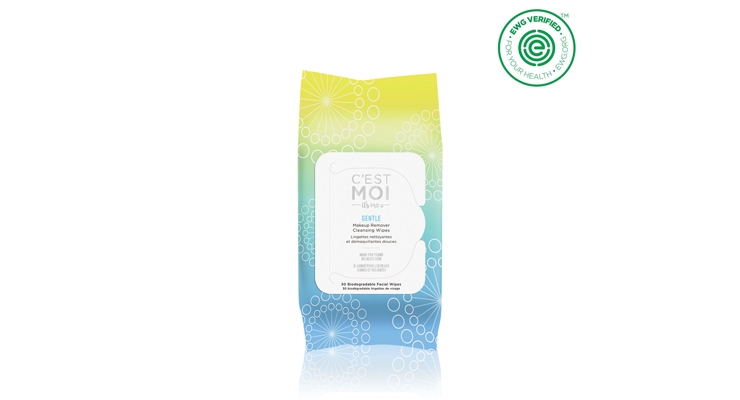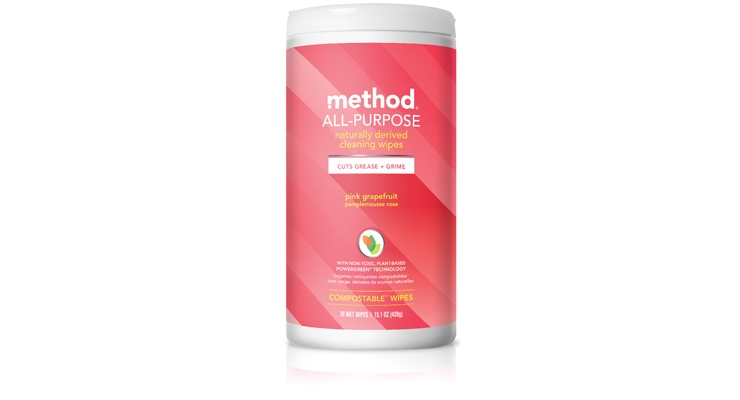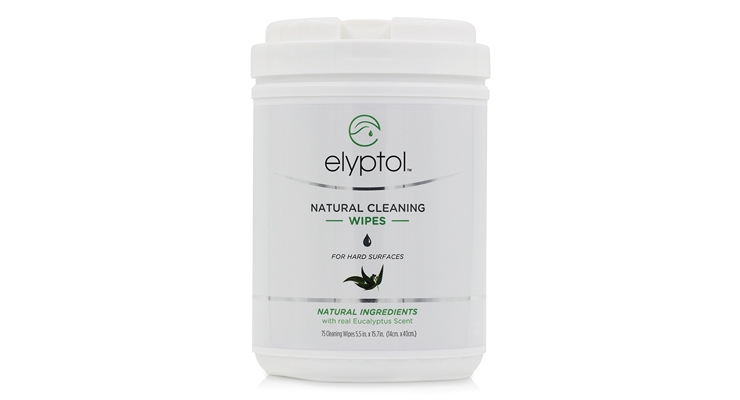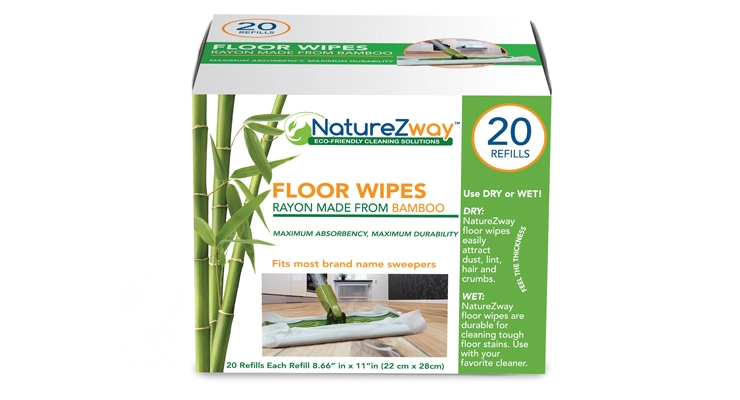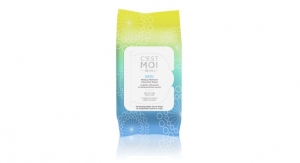Tara Olivo, Associate Editor04.05.19
Demand for natural and organic products continues to grow—in skincare, household products, food—and the wipes market is no exception. Natural can mean different things to different people. On one hand, some believe fewer ingredients to be more natural, while others may consider products derived from plant-based materials to meet their “natural” criteria.
Phil Mango, nonwovens author and associate consultant at Smithers Pira, defines a “natural” wipe as one composed of all “natural” fibers and lotion ingredients. For fibers, it would be those derived from nature—cotton, or cellulosic fibers like rayon, lyocell, flax, etc., while polyester, polypropylene, and polyethylene are not. For lotions, ingredients like aloe, lanolin, citric acid would be considered natural.
“Natural wipes are definitely a growing market,” Mango says. “The raw materials used in natural wipes are usually renewable, less damaging to the environment in processing and sometimes are even lower cost. They are biodegradable and compostable. Based on plants, they absorb carbon dioxide and release oxygen. Growing more trees is desirable on its own merit; gaining natural raw materials for wipes like wood pulp and lyocell is a bonus.”
In the Smithers Pira market report “The Future of Global Nonwoven Wipes to 2023,” the percentage of natural raw materials used in wipes is projected to increase from 54% in 2013 to 59.2% in 2023. “This is on a global basis; regions like Western Europe and North America are converting to more natural materials even faster,” Mango explains.
On the whole, “natural” is trending because the global consumer has become more educated in the overall health of the planet and its people, he adds. “The sustainability movement has been growing for years, waxing and waning based on global and regional economics and sometimes even technology. Overall, the trend has been clear and significant; consumers want more sustainable products and natural wipes are one piece of the puzzle.”
Despite the popularity of natural products—including wipes—they do face some challenges.
“Cost of natural wipes alternatives can be significantly higher and sometimes there are not yet acceptable natural alternatives. Although the consumer wants natural products, they also do not want to pay a lot more for them; nor do they want to give up a lot of performance,” Mango admits.
Natural preservatives can also be a challenge for wipes makers. “With natural preservatives, the challenge is performance,” he explains. “If products touting natural preservatives have major failures (to preserve), the consumer will lose confidence and again refuse to buy. In a consumer market like wipes, consumer confidence and impressions can make or break a market.”
The New Naturals
The number of natural skincare brands adding wipes to their portfolios keeps growing as they realize today’s consumers look for this convenient option when they are on-the-go or traveling.
C’est Moi, a beauty brand created for tweens and teens, recently launched makeup remover cleansing wipes as part of a new Gentle Cleansing Collection of products. Natural ingredients include organic aloe, calendula, extracts of strawberry, cucumber, kiwi and apple, green tea, as well as chamomile water, organic sweet almond oil, and Shea butter.
Jennifer Saul, vice president of marketing at C’est Moi, says that on-the-go cleansers and makeup remover wipes have seen tremendous growth within the skin care category. “There is strong demand for convenient and portable solutions that are gentle on the skin and eyes, but also effectively remove dirt and makeup easily on-the-go,” she says.
Meanwhile, Derma E, a natural, clean beauty skin care brand, recently launched Vitamin C Brightening Micellar Wipes. The new 100% biodegradable wipes gently exfoliate the skin while lifting away makeup, oil, and impurities.
Derma E has one of the only biodegradable skin care wipes in beauty, claims its chief marketing officer Barbara Roll. “We wanted to promote this as an option and in our high performing Vitamin C line where you not only have the benefit of cleansing, removing makeup, but brightening and enriching the skin with a non-oxidizing, highly effective Vitamin C form option in a environmentally friendly, 100% biodegradable cleansing wipe.”
Meanwhile, Pacifica, a natural skincare and makeup company, recently expanded its range of wipes to include Sea Foam Makeup Removing Foaming Wipes, based on its popular Sea Foam Complete Face Wash. The new wipes are infused with skin-loving naturals like coconut water, calendula and chamomile.
On the home care side, Method, which makes naturally-derived, biodegradable, non-toxic household cleaners, laundry supplies, personal care products and soap, recently introduced all-purpose cleaning wipes in its popular scents lime + sea salt, pink grapefruit and french lavender. The nonwoven-based substrate is made with Tencel fiber and is compostable in municipal composting facilities. The non-toxic formulation packs a powerful cleaning punch with naturally derived ingredients. Cleaners made with corn and coconut whisk away spills and splatters with ease.
Method’s new wipes are already making waves. In March, the All-Purpose Pink Grapefruit Cleaning Wipes were honored with a NEXTY Award at Natural Products Expo West, the world’s largest natural, organic and healthy products event. The wipes took home the honor for the Consumer Choice Personal Care or Natural Living Product category.
A Green Clean
Hand sanitizing company Elyptol started in Australia and makes all natural 99.999% germ kill gels and sprays, hand wipes and hard surface wipes.
Elyptol president and CEO Tim O’Connor founded the company for personal reasons. When his daughter was born, his family was using the hospital provided sanitizers. He thought they were the best option, but soon realized they were laden with chemicals like chlorhexidine, benzalkonium chloride and isopropyl alcohol. His wife’s skin on her fingertips began to crack and was sore. “Some of these chemicals are super harmful to our skin and some of them turn to acetone, which takes a long time for the body to get rid of,” O’Connor says.
Elyptol’s formulations are based on ethanol—which is derived from sugar cane or corn—combined with Eucalyptus Oil as the denaturant, which has the ability to achieve high kill efficacy balanced with improved skin health.
“The products are the strongest, safest, efficacious products on the global market today. We’re the strongest, at 99.9999% efficacy,” O’Connor says.
The company had a lot of requests for Elyptol in a wipe format. “When you’re on the move, driving or walking and grabbing food on the go, you just want to wipe your hands—you don’t want to use a spray. With many competitors’ products, you put on a gel and it slips off right off, not to mention how sticky it is. So we had a lot of interest in our product because Elyptol doesn’t slip off your hands, is not sticky and moisturizes. But if you’re on the go and your baby has an accident and you want to wipe your hands quickly so you don’t pass the germs across, you need a wipe.”
Although the wipes can’t be used for diaper changes, O’Connor says they can be used to clean baby’s hands since there are no harmful chemicals in them. Elyptol Antimicrobial Hand Sanitizer Wipes are 100% natural, made with a bamboo-based nonwoven substrate, and are available in a box of 24 single sachets, 10 count packets and a 60-count canister.
Unlike some of the big-name competitor’s out there, Elyptol’s Natural Cleaning Hard Surface Wipes are safe on hands, O’Connor says. “With most cleaning wipes that you buy on the shelf, you’re supposed to use gloves, or wash your hands immediately. With our products, you don’t need gloves. You pull it out of the container and you can start wiping your kitchen benches and stovetops – and even use them to wipe your hands. And as an added bonus, your kitchen smells with the clean scent of eucalyptus, not that odd smell of chemicals.”
Elyptol’s Natural Cleaning Hard Surface Wipes are available in 65-count or 75-count canisters.
For its part, NatureZway develops eco-friendly, nonwoven-based products including bamboo floor wipes, bamboo sponges and cloths and kitchen bamboo towels. NatureZway considers its products natural because they don’t use bleach or chemicals to whiten them, only hydrogen peroxide, according to the company’s CEO Sean Solouki. Rayon made from bamboo is more durable, super absorbent and also saves trees, he adds.
“Consumers not only now believe in the helping of the environment and would like to be, remain or become eco-friendly and eco-conscious, but they also do care about their health and have concerns in having safe or more safe products in their household,” Solouki says.
Wipes are an important part of the company’s cleaning business. “We specialize in this area, so for us to add wipes to our eco-friendly cleaning category was important. Wipes are also a huge consumption, so a natural wipe would certainly make a difference in the environment.”
In the coming months, NatureZway plans to launch a bamboo wet floor wipe.
It’s What’s Inside that Counts
Jarchem is a manufacturer and global supplier of specialty chemicals and natural materials, developing functional, consumer conscious and environmentally-friendly ingredients from plant, mineral and fermentation sources.
For an ever developing market concerned about synthetic, irritating, and silicone loaded products, Jarchem recently developed an all-natural, patent pending makeup remover that works as an effective alternative removing most waterproof and difficult to remove makeup items.
Jarplex MUR is a powerful makeup remover composed of Isopropyl Shea Butterate and plant derived paraffins. This unique combination of natural ingredients provides exceptional makeup removing benefits that outperforms current makeup removers on the market typically containing silicones, Isopropyl Myristate (IPM), and Isopropyl Palmitate (IPP), according to the company. Silicones, IPM, and IPP are known to be high on the comedogenic scale and result in greater pore clogging in the skin over continuous daily use. The Isopropyl Shea Butterate in Jarplex MUR is made up of stearic acid and oleic acid, which are proven to be significantly lower on the comedogenic scale and thus not as pore clogging when used daily. The skin feel is exceptional and comparable to silicones as it has great spreadibility and minimal residual feel.
Unlike other natural makeup remover options that utilize coconut oil-based removers or mineral oils, Jarplex MUR does not leave a greasy or tacky after-feel and instead makes skin feel velvety soft.
Stephen Carter, personal care product manager at Jarchem, believes wipes are an ideal application for this new natural makeup remover given the lack of natural, effective wipes available in the market. “Jarplex MUR can offer consumers a gentle, non-abrasive and effective wipe while remaining natural and safe for the eyes,” he says. “Cleansing and makeup removing wipes are becoming very popular in our industry due to beauty-on-go and athleisure beauty trends. The one-time use and portability of a wipe fits in perfectly with our on-the-go and quick results generation.”
Today consumers are more aware of what they’re putting in their bodies and on their skin because they have further outreach, he adds. “With information readily available at our fingertips with an internet search, consumers are becoming more educated on what they buy and what’s inside. Although not all information out there is true or harmful, I believe consumers take the safer approach by having loyalty to products with more naturally–derived ingredients.”
Phil Mango, nonwovens author and associate consultant at Smithers Pira, defines a “natural” wipe as one composed of all “natural” fibers and lotion ingredients. For fibers, it would be those derived from nature—cotton, or cellulosic fibers like rayon, lyocell, flax, etc., while polyester, polypropylene, and polyethylene are not. For lotions, ingredients like aloe, lanolin, citric acid would be considered natural.
“Natural wipes are definitely a growing market,” Mango says. “The raw materials used in natural wipes are usually renewable, less damaging to the environment in processing and sometimes are even lower cost. They are biodegradable and compostable. Based on plants, they absorb carbon dioxide and release oxygen. Growing more trees is desirable on its own merit; gaining natural raw materials for wipes like wood pulp and lyocell is a bonus.”
In the Smithers Pira market report “The Future of Global Nonwoven Wipes to 2023,” the percentage of natural raw materials used in wipes is projected to increase from 54% in 2013 to 59.2% in 2023. “This is on a global basis; regions like Western Europe and North America are converting to more natural materials even faster,” Mango explains.
On the whole, “natural” is trending because the global consumer has become more educated in the overall health of the planet and its people, he adds. “The sustainability movement has been growing for years, waxing and waning based on global and regional economics and sometimes even technology. Overall, the trend has been clear and significant; consumers want more sustainable products and natural wipes are one piece of the puzzle.”
Despite the popularity of natural products—including wipes—they do face some challenges.
“Cost of natural wipes alternatives can be significantly higher and sometimes there are not yet acceptable natural alternatives. Although the consumer wants natural products, they also do not want to pay a lot more for them; nor do they want to give up a lot of performance,” Mango admits.
Natural preservatives can also be a challenge for wipes makers. “With natural preservatives, the challenge is performance,” he explains. “If products touting natural preservatives have major failures (to preserve), the consumer will lose confidence and again refuse to buy. In a consumer market like wipes, consumer confidence and impressions can make or break a market.”
The New Naturals
The number of natural skincare brands adding wipes to their portfolios keeps growing as they realize today’s consumers look for this convenient option when they are on-the-go or traveling.
C’est Moi, a beauty brand created for tweens and teens, recently launched makeup remover cleansing wipes as part of a new Gentle Cleansing Collection of products. Natural ingredients include organic aloe, calendula, extracts of strawberry, cucumber, kiwi and apple, green tea, as well as chamomile water, organic sweet almond oil, and Shea butter.
Jennifer Saul, vice president of marketing at C’est Moi, says that on-the-go cleansers and makeup remover wipes have seen tremendous growth within the skin care category. “There is strong demand for convenient and portable solutions that are gentle on the skin and eyes, but also effectively remove dirt and makeup easily on-the-go,” she says.
Meanwhile, Derma E, a natural, clean beauty skin care brand, recently launched Vitamin C Brightening Micellar Wipes. The new 100% biodegradable wipes gently exfoliate the skin while lifting away makeup, oil, and impurities.
Derma E has one of the only biodegradable skin care wipes in beauty, claims its chief marketing officer Barbara Roll. “We wanted to promote this as an option and in our high performing Vitamin C line where you not only have the benefit of cleansing, removing makeup, but brightening and enriching the skin with a non-oxidizing, highly effective Vitamin C form option in a environmentally friendly, 100% biodegradable cleansing wipe.”
Meanwhile, Pacifica, a natural skincare and makeup company, recently expanded its range of wipes to include Sea Foam Makeup Removing Foaming Wipes, based on its popular Sea Foam Complete Face Wash. The new wipes are infused with skin-loving naturals like coconut water, calendula and chamomile.
On the home care side, Method, which makes naturally-derived, biodegradable, non-toxic household cleaners, laundry supplies, personal care products and soap, recently introduced all-purpose cleaning wipes in its popular scents lime + sea salt, pink grapefruit and french lavender. The nonwoven-based substrate is made with Tencel fiber and is compostable in municipal composting facilities. The non-toxic formulation packs a powerful cleaning punch with naturally derived ingredients. Cleaners made with corn and coconut whisk away spills and splatters with ease.
Method’s new wipes are already making waves. In March, the All-Purpose Pink Grapefruit Cleaning Wipes were honored with a NEXTY Award at Natural Products Expo West, the world’s largest natural, organic and healthy products event. The wipes took home the honor for the Consumer Choice Personal Care or Natural Living Product category.
A Green Clean
Hand sanitizing company Elyptol started in Australia and makes all natural 99.999% germ kill gels and sprays, hand wipes and hard surface wipes.
Elyptol president and CEO Tim O’Connor founded the company for personal reasons. When his daughter was born, his family was using the hospital provided sanitizers. He thought they were the best option, but soon realized they were laden with chemicals like chlorhexidine, benzalkonium chloride and isopropyl alcohol. His wife’s skin on her fingertips began to crack and was sore. “Some of these chemicals are super harmful to our skin and some of them turn to acetone, which takes a long time for the body to get rid of,” O’Connor says.
Elyptol’s formulations are based on ethanol—which is derived from sugar cane or corn—combined with Eucalyptus Oil as the denaturant, which has the ability to achieve high kill efficacy balanced with improved skin health.
“The products are the strongest, safest, efficacious products on the global market today. We’re the strongest, at 99.9999% efficacy,” O’Connor says.
The company had a lot of requests for Elyptol in a wipe format. “When you’re on the move, driving or walking and grabbing food on the go, you just want to wipe your hands—you don’t want to use a spray. With many competitors’ products, you put on a gel and it slips off right off, not to mention how sticky it is. So we had a lot of interest in our product because Elyptol doesn’t slip off your hands, is not sticky and moisturizes. But if you’re on the go and your baby has an accident and you want to wipe your hands quickly so you don’t pass the germs across, you need a wipe.”
Although the wipes can’t be used for diaper changes, O’Connor says they can be used to clean baby’s hands since there are no harmful chemicals in them. Elyptol Antimicrobial Hand Sanitizer Wipes are 100% natural, made with a bamboo-based nonwoven substrate, and are available in a box of 24 single sachets, 10 count packets and a 60-count canister.
Unlike some of the big-name competitor’s out there, Elyptol’s Natural Cleaning Hard Surface Wipes are safe on hands, O’Connor says. “With most cleaning wipes that you buy on the shelf, you’re supposed to use gloves, or wash your hands immediately. With our products, you don’t need gloves. You pull it out of the container and you can start wiping your kitchen benches and stovetops – and even use them to wipe your hands. And as an added bonus, your kitchen smells with the clean scent of eucalyptus, not that odd smell of chemicals.”
Elyptol’s Natural Cleaning Hard Surface Wipes are available in 65-count or 75-count canisters.
For its part, NatureZway develops eco-friendly, nonwoven-based products including bamboo floor wipes, bamboo sponges and cloths and kitchen bamboo towels. NatureZway considers its products natural because they don’t use bleach or chemicals to whiten them, only hydrogen peroxide, according to the company’s CEO Sean Solouki. Rayon made from bamboo is more durable, super absorbent and also saves trees, he adds.
“Consumers not only now believe in the helping of the environment and would like to be, remain or become eco-friendly and eco-conscious, but they also do care about their health and have concerns in having safe or more safe products in their household,” Solouki says.
Wipes are an important part of the company’s cleaning business. “We specialize in this area, so for us to add wipes to our eco-friendly cleaning category was important. Wipes are also a huge consumption, so a natural wipe would certainly make a difference in the environment.”
In the coming months, NatureZway plans to launch a bamboo wet floor wipe.
It’s What’s Inside that Counts
Jarchem is a manufacturer and global supplier of specialty chemicals and natural materials, developing functional, consumer conscious and environmentally-friendly ingredients from plant, mineral and fermentation sources.
For an ever developing market concerned about synthetic, irritating, and silicone loaded products, Jarchem recently developed an all-natural, patent pending makeup remover that works as an effective alternative removing most waterproof and difficult to remove makeup items.
Jarplex MUR is a powerful makeup remover composed of Isopropyl Shea Butterate and plant derived paraffins. This unique combination of natural ingredients provides exceptional makeup removing benefits that outperforms current makeup removers on the market typically containing silicones, Isopropyl Myristate (IPM), and Isopropyl Palmitate (IPP), according to the company. Silicones, IPM, and IPP are known to be high on the comedogenic scale and result in greater pore clogging in the skin over continuous daily use. The Isopropyl Shea Butterate in Jarplex MUR is made up of stearic acid and oleic acid, which are proven to be significantly lower on the comedogenic scale and thus not as pore clogging when used daily. The skin feel is exceptional and comparable to silicones as it has great spreadibility and minimal residual feel.
Unlike other natural makeup remover options that utilize coconut oil-based removers or mineral oils, Jarplex MUR does not leave a greasy or tacky after-feel and instead makes skin feel velvety soft.
Stephen Carter, personal care product manager at Jarchem, believes wipes are an ideal application for this new natural makeup remover given the lack of natural, effective wipes available in the market. “Jarplex MUR can offer consumers a gentle, non-abrasive and effective wipe while remaining natural and safe for the eyes,” he says. “Cleansing and makeup removing wipes are becoming very popular in our industry due to beauty-on-go and athleisure beauty trends. The one-time use and portability of a wipe fits in perfectly with our on-the-go and quick results generation.”
Today consumers are more aware of what they’re putting in their bodies and on their skin because they have further outreach, he adds. “With information readily available at our fingertips with an internet search, consumers are becoming more educated on what they buy and what’s inside. Although not all information out there is true or harmful, I believe consumers take the safer approach by having loyalty to products with more naturally–derived ingredients.”

